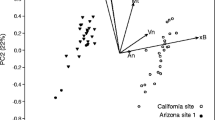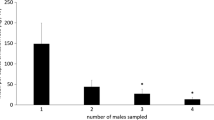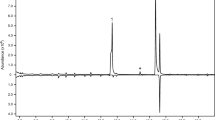Abstract
The total amounts of, and proportions among, components of the aggregation pheromone produced byIps typographus were found to vary considerably among individuals excised from attacks on standing spruce trees. Chemical analyses of 392 individual male beetles were made by GC-MS. Both unmated and mated males had log-normal frequency distributions in their content of the pheromone components 2-methyl-3-buten-2-ol (MB) andcis-verbenol (cV), since a large fraction of males had a low content. The amount of MB in male hindguts varied independently of cV and the other oxygenated monoterpenes, while the amount of cV covaried with the other pinene alcohols and showed a variation between beetles from different spruce trees. Mated males had, on average, lower amounts of MB than unmated, while the average content of cV in mated males varied with the resin content of their host trees. Ipsdienol and ipsenol were only found in mated males, but in less than 40% and 10%, respectively, of these mated males. Even-aged males exposed to α-pinene in the laboratory showed slightly less variation in the amounts of verbenols, and the variations in ratio between cV and tV were similar to those among males attacking the same spruce tree.
Similar content being viewed by others
References
Alcock, J. 1982. Natural selection and communication among bark beetles.Fla. Entomol. 65: 17–32.
Anderbrant, O., Schlyter, F., andBirgersson, G. 1985. Intraspecific competition affecting parents and offspring in the bark beetleIps typographus.Oikos 45:89–98.
Anonymous. 1980. Guidelines for data acquisition and data quality evaluation in environmental chemistry. ASC committee on environmental improvement.Anal. Chem. 52:2242–2249.
Atkins, M.D. 1969. Lipid loss with flight in the Douglas-fir beetle.Can. Entomol. 101:164–165.
Bakke, A. 1976. Spruce bark beetle,Ips typographus: Pheromone production and field response to synthetic pheromone.Naturwissenschaften 63:92.
Bakke, A. 1981. Inhibition of the response inIps typographus to the aggregation pheromone: Field evaluation of verbenone and ipsenol.Z. Angew. Entomol. 92:172–177.
Berryman, A.A. 1982. Population dynamics of bark beetles, pp. 264–314,in J.B. Mitton and K.B. Sturgeon (eds.). Bark Beetles in North American Conifers. University of Texas Press, Austin.
Birgersson, G. 1989. Host tree resistance influencing pheromone production inIps typographus (Coleoptera: Scolytidae).Holarc. Ecol. In press.
Birgersson, G., Schlyter, F., Löfqvist, J., andBergström, G. 1984. Quantitative variation of pheromone components in the spruce bark beetleIps typographus from different attack phases.J. Chem. Ecol. 10:1029–1055.
Birgersson, G., andBergström, G. 1989. Volatiles released from individual spruce bark beetle entrance holes: Quantitative variations during the first week of attack.J. Chem. Ecol. Submitted.
Borden, J.H. 1982. Aggregation pheromones, pp. 74–139,in J.B. Mitton and K.B. Sturgeon (eds.). Bark Beetles in North America Conifers. University of Texas press, Austin.
Borden, J.H., Hunt, D.W.A., Miller, D.A., andSlessor, K.N. 1986. Orientation in forest Coleoptera: An uncertain outcome of responses by individual beetles to variable stimuli, pp. 97–109in T.L. Payne, M.C. Birch, and C.E.J. Kennedy (eds.). Mechanisms in Insect Olfaction. Oxford University Press, Oxford.
Byers, I.A. 1981. Pheromone biosynthesis in the bark beetleIps paraconfusus, during feeding or exposure to vapours of host plant precursors.Insect Biochem. 11:563–569.
Byers, J.A. 1983. Bark beetle conversion of a plant compound to a sex-specific inhibitor of pheromone attraction.Science 220:624–626.
Byers, J.A., andWood, D.L. 1980. Interspecific inhibition of the response of the bark beetles,Dendroctonus brevicomis andIps paraconfusus, to their pheromones in the field.J. Chem. Ecol. 6:149–164.
Fish, R.H., Browne, L.E., Wood, D.L., andHendry, L.B. 1979. Pheromone biosynthetic pathways: Conversion of deuterium labelled ipsdienol with sexual and enantioselectivity inIps paraconfusus Lanier.Tetrahedron Lett. 17:1465–1468.
Francke, W., andVité, J.P. 1983. Oxygenated terpenes in pheromone systems of bark beetles.Z. Angew. Entomol. 96:146–156.
Hackstein, E., andVité, J.P. 1978. Pheromonbiosynthese und Reizkette in der Besiedlung von Fichten durch den BuchdruckerIps typographus.Mitt. Dtsch. Ges. Allg. Angew. Entomol. 1:185–188.
Hughes, P.R. 1974. Myrcene: A precursor of pheromones inIps beetles.J. Insect Physiol. 20:1271–1275.
Hunt, D.W.A., Borden, J.H., Pierce, H.D., Jr., Slessor, K.N., King, G.G.S., andCzyzewska, E.K. 1986. Sex-specific production of ipsdienol and myrcenol byDendroctonus ponderosae (Coleptera: Scolytidae) exposed to myrcene vapors.J. Chem. Ecol. 12:1579–1586.
Klimetzek, D., andFrancke, W. 1980. Relationship between the enantiomeric composition of α-pinene in host trees and the production of verbenols inIps species.Experentia 36:1343–1344.
Lanne, B.S., Bergström, G., Wassgren, A.-B., andTörnbäck, B. 1987. Double bond pattern of straight chain marking compounds in bumble bee males.Comp. Biochem. Physiol. 888:631–636.
Leufvén, A., andBirgersson, G. 1987. Quantitative variation of different monoterpenes around galleries ofIps typographus (Coleoptera: Scolytidae) attacking Norway spruce.Can. J. Bot. 65:1038–1044.
Leufvén, A., Bergström, G., andFalsen, E. 1984. Interconversion of verbenols and verbenone by identified yeasts isolated from the spruce bark beetleIps typographus.J. Chem. Ecol. 10:1349–1361.
Lindström, M.,Norin, T.,Birgersson, G., andSchlyter, F. 1988. Variation of enantiomeric composition of α-pinene in Norway spruce,Picea abies, and its influence on the production of verbenol isomers byIps typographus in the field.J. Chem. Ecol. In press.
Raffa, K.F., andBerryman, A.A. 1983. The role of host resistance in the colonization behavior and ecology of bark beetles (Coleoptera; Scolytidae).Ecol. Monogr. 53:27–49.
Renwick, J.A.A., Huges, P.R., andKrull, I.S. 1976. Selective production ofcis- andtrans- verbenol from (−)- and (+)-α-pinene by a bark beetle.Science 191:199–201.
Schlyter, F., andBirgersson, G. 1989. Individual variation of pheromone in bark beetles and moths—a comparison and an evolutionary background.Holarct. Ecol. In press.
Schlyter, F., andCederholm, I. 1981. Separation of the sexes of living spruce bark beetles,Ips typographus (L.), (Coleoptera; Scolytidae).Z. Angew. Entomol. 92:42–47.
Schlyter, F., andLöfqvist, J. 1986. Response of walking spruce bark beetlesIps typographus to pheromone produced in different attack phases.Entomol. Exp. Appl. 41:219–230.
Schlyter, F., Birgersson, G., Byers, J.A., Löfqvist, J., andBergström, G. 1987a. Field response of the spruce bark beetleIps typographus to aggregation pheromone candidates.J. Chem. Ecol. 13:701–716.
Schlyter, F., Byers, J.A., andLöfqvist, J. 1987b. Attraction to pheromone sources of different quantity, quality and spacing: Density regulation mechanisms in the bark beetleIps typographus.J. Chem. Ecol. 13:1503–1523.
Slessor, K.N., King, G.G.S., Miller, D.R., Winston, M.L., andCutford, T.L. 1985. Determination of chirality of alcohol or latent alcohol semiochemicals in individual insects.J. Chem. Ecol. 11:1659–1667.
Smith, R.H. 1965. Effect of monoterpene vapours on western pine beetle.J. Econ. Entomol. 58:509–510.
Sokal, R., andRohlf, F. 1981. Biometry, 2nd. ed. W.H. Freeman, San Francisco.
Wold, S., Albano, C., Dunn, W.J., Edlund, U., Esbensen, K., Geladi, P., Hellberg, S., Johansson, E., Lindberg, W., andSjöstrom, M. 1984. Multivariate data analysis in chemistry, pp. 17–96,in B.R. Kowalski (ed.). Proceedings NATO Advanced Study Institute on Chemometrics: Mathematics and Statistics in Chemistry, Cosenza, Italy, September 1983. D. Reidel, Dordrecht, Holland.
Wright, L.C., Berryman, A.A., andGurusiddaiah, S. 1979. Host resistance to fir engraver beetleScolytus ventralis (Coleoptera: Scolytidae). 4. Effect of defoliation on wound mono-terpenes and phloem carbohydrate concentration.Can. Entomol. 111:1255–1262.
Author information
Authors and Affiliations
Additional information
Coleoptera, Scolytidae.
This study was made within the Swedish project “Odour Signals for Control of Pest Insects.”
Rights and permissions
About this article
Cite this article
Birgersson, G., Schlyter, F., Bergström, G. et al. Individual variation in aggregation pheromone content of the bark beetle,Ips typographus . J Chem Ecol 14, 1737–1761 (1988). https://doi.org/10.1007/BF01014641
Received:
Accepted:
Issue Date:
DOI: https://doi.org/10.1007/BF01014641




